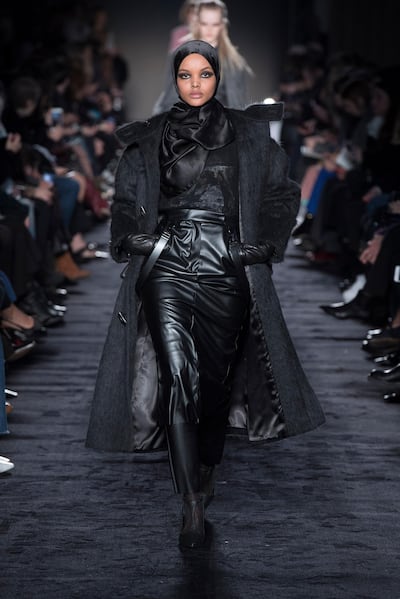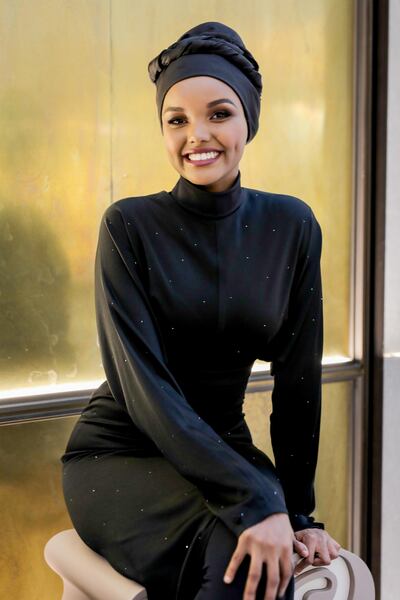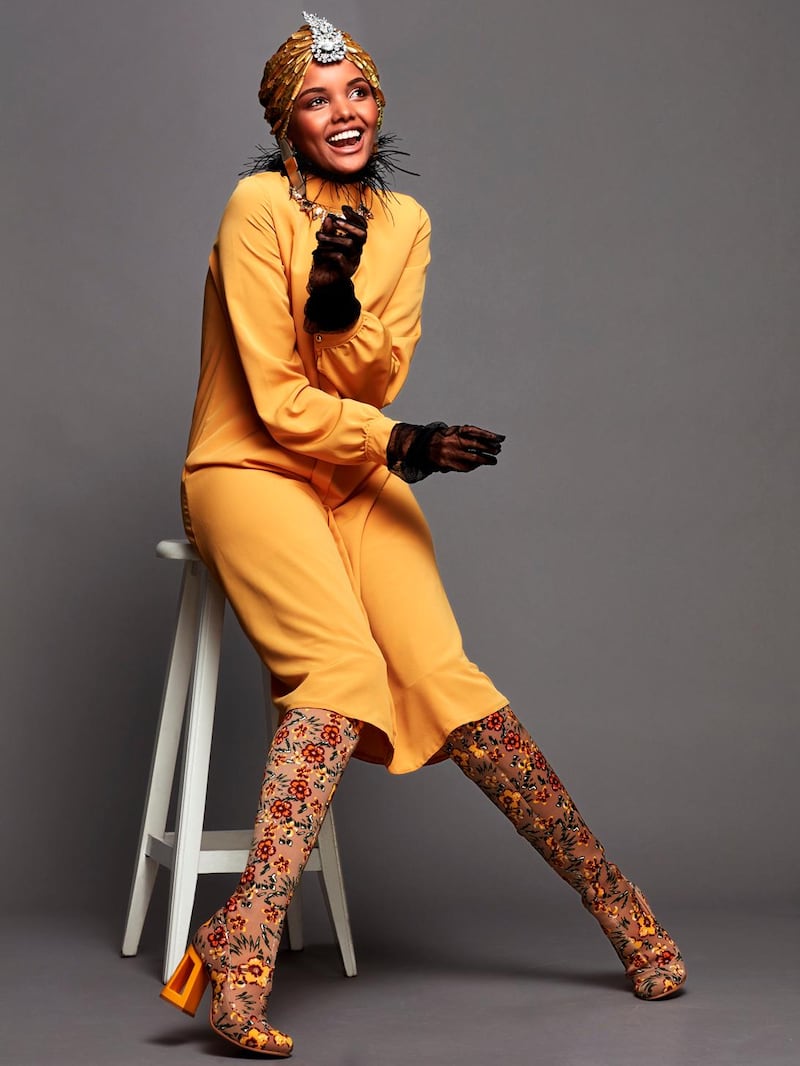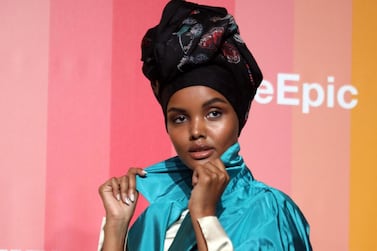A patterned blue and green kaftan is hitched up to the thigh, revealing a cobalt-coloured bodysuit underneath. Lounging in the water, her hair wrapped in a matching turban, Halima Aden sports a beaming smile – perhaps understandably. The Somali-American is making history as the first hijab-wearing model to be featured in Sports Illustrated's famed Swimsuit issue.
While a burkini-clad model on the pages of a publication best known for displaying lithe, semi-clad bodies may sound contradictory, Aden has made a habit of shattering perceptions and leaving a touch of controversy in her wake.
The model, who I meet at a quaint hotel on the banks of the Bosphorus, is strong-willed, level-headed, independent and confident with the journey she's on. She's a Muslim, she's a refugee, she's American and she wears a hijab, and she sees no conflict at all between her faith and her career.
On going from a refugee camp to Miss Minnesota
Aden’s story is widely known. The 21-year-old Somali was born in a refugee camp in Kenya and moved to the United States when she was six. “I think any time you go from being a refugee to moving, you have a wide range of culture shocks; you almost have to reprogramme your entire life,” says Aden, who spoke fluent Somali and Swahili, but had to learn English from scratch when she emigrated. Today, she has the animated drawl of a born Minnesotan.
In high school, a teenage Aden was voted homecoming queen and, in 2016, she competed in the Miss Minnesota beauty pageant, becoming the first hijab-wearing contestant in the competition. She was a semi-finalist and, for the swimwear sequence, opted to wear a burkini – making headlines nationwide at a time when post-9/11 Islamophobia was still rampant, and niqabs and burkinis were being banned in many places. After signing with modelling agency IMG, she made her first real foray into fashion in 2017 when she featured in Kanye West's Yeezy presentation at New York Fashion Week, followed by runway appearances for Max Mara and Alberta Ferretti in Milan.
'Halima the hanger'
Coming from a Muslim background where modelling is often considered taboo, some of Aden’s family members were sceptical at first. “I think that’s something that girls relate to me on,” she says. “I do have a very traditional Somali Muslim mum.”
In Aden’s family, occupations such as nursing and teaching are considered to be more suitable for women. “They don’t necessarily understand that modelling is a real job; I think that’s what I struggle with culturally,” she says. The model remembers calling her aunt after walking the runways in Milan. “I told her: ‘Oh my gosh, I just walked at Milan Fashion Week; this is kind of a huge deal, I’m wearing a hijab and on top of that I’m wearing braces, so who would have ever thought I’d be walking in any show?’”

“In America, walking around in heels is considered a job?” was her aunt’s response. Now, she jokingly calls her famous niece “Halima the hanger.” But Aden sees herself as much more than a mere clothes horse. “Today, I think what’s considered as modelling has changed so much. With social media, I feel like modelling has become so much more; it’s no longer about photo shoot – model – buy,” she says.
Her work now involves public speaking at university campuses, as well as being an ambassador for Unicef. "It doesn't pay me, but it fulfils me in the places that really matter," explains Aden. The young model is also excited about her latest venture – her first design collaboration, with popular modestwear website, Modanisa, which is known for its stylish, hijab-friendly apparel. The collection focuses on sculptural turbans in jewel tones, metallic finishes and graphic patterns.
No more 'bad hijab' days
As modest fashion has gained popularity in recent years, vloggers have taken to YouTube to post hijab-tying tutorials, and intricately wrapped turbans started trending among millennials who cover their hair. But achieving these looks took time, concentration and a handfuls of pins. What's unique about the Halima x Modanisa turbans is that they are already tied and knotted, rather than coming as long scarves that require constant pinning and adjusting.

“Pre-tied, and no more pins,” says Aden, telling me that she has, in the past, walked into an event with her turban facing one way, and left with it looking completely different. “People ask: ‘When did you have time to change?’ Girl, it slipped! You know how there’s bad hair day? I’ve had some really bad hijab days.”
Aden says that for women, the process of getting ready is already time-consuming enough. “So your hijab, your turban, your scarf, should not be something that brings hassle to your life; girls should be able to put it on and take 20 seconds, max, to fluff it out,” she says. “The Halima x Modanisa turbans are for girls to feel their absolute most comfortable; they’re effective and practical, but also fashionable, and I think that’s something that was maybe missing.”
The target market for the collaboration, explains the model, is not just hijab-wearing Muslims. The turbans can be treated like hats, and worn by all women, for any occasion – be it a day at the beach or a formal gala event. Head coverings are not a solely Muslim style, after all – Aden tells me she has witnessed the headscarf's gradual emergence into the mainstream over the past few years.
When she first started modelling, Aden would have to bring her own hijabs when travelling to European fashion weeks, but for her second runway show with Max Mara, she was presented with a headscarf that he had designed just for her. "And coming back the third time, he had 10 or 12 of us girls – I wasn't the only one with her hair covered; it became part of the look."
For his spring/summer 2018 show, designer Marc Jacobs also incorporated headscarves, wrapped as turbans, on every model on his runway. "Headpieces were being celebrated," says Aden. "It's no longer a 'Muslim women head covering' thing, you know. Turbans are in."
Islamic values versus a modelling career
While Aden has built up an enormous fan base, not all fellow Muslims applaud her actions. Take her appearance in April's edition of Sports Illustrated, for instance. While the portrayal of a burkini-clad model in a traditionally skin-baring publication was celebrated by many Muslim women, others within the community found the photographs to be at odds with the inherent purpose of the hijab.
Aden has come to embody the debate that lies at the heart of the whole “modest” fashion movement: the hijab is essentially viewed as a veil of privacy, while having your image printed in magazines attracts attention in the public sphere. But does Aden see any conflict between her Islamic values and modelling career? Certainly not.
“I’m not Rapunzel stuck in a castle,” she says defiantly. “In today’s society, you’re out and about, and you’re visible, no matter what. So why is it OK for me to be visible in a classroom? Why is it OK to be out in a mall, or just outside, but I can’t be seen in a magazine?” she asks.
Aden also points out that some critics are two-faced – the ones she calls the “haram police”, who leave nasty comments on her Instagram photos, for example. “This actually does bother me, because people will say modelling is haram, but then they’re the ones commenting on my photos on Instagram and they themselves have photos on public platforms – it’s just the hypocrisy of it all. I’m really learning now you have to live for you, and that’s the advice I give to girls, because if you listen to every single person who has an opinion, you’re going to be stuck not living at all.”
Another controversial aspect of being a hijab-wearing model is the non-segregated nature of the fashion industry. Many popular photographers and make-up artists are male, and some Muslim models stipulate that they’ll only work with all-female crews for shoots. But Aden raises the point that in all sectors, men and women work together, so why should rules be any different for Muslim women working in fashion?
“That’s part of being in today’s society. Women and men work alongside each other, and even if I was a teacher, or a university student, those [men] would be my peers and my colleagues,” she says.
Religious debate aside, there's absolutely no denying that Aden's entrance into the mainstream fashion world helped open doors for other young hijab-wearing women. Names such as Mariah Idrissi, Shahira Yusuf and Feriel Moulai, for instance, are now covering magazines, starring on runways and featuring in campaigns with luxury brands across the globe. And the movement isn't just confined to the fashion industry – American Muslim fencing champion Ibtihaj Muhammad and congresswoman Ilhan Abdullahi Omar are also hijab-wearing females in the limelight.
"There's a whole wide range of hijab-wearing women who are doing incredible things with their professions; who aren't necessarily getting the clicks on Instagram, who aren't trending on Twitter, but they matter," Aden says.
While she may have fashion to thank for her fame, Aden has become an ambassador for inclusion and diversity. Having taken a break from attending college to explore opportunities in modelling, public speaking and perhaps some more design collaborations, she hints, Aden doesn’t have a solid plan for the next few years. She tells me that she’s spontaneous, and likes to go with the flow, and what more can we expect from a 21-year-old? But if there’s one thing she’s unapologetically certain of, it’s her identity. “I’m a proud Somali-American refugee, and I’m a proud Minnesotan – those are titles I’m proud to have,” she says, “and being a hijab-wearing model is something that I’m always going to treasure.”







